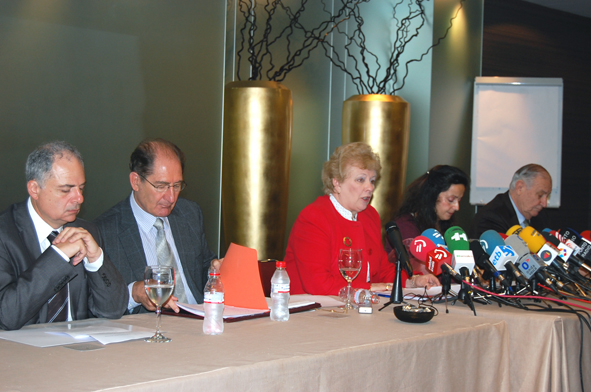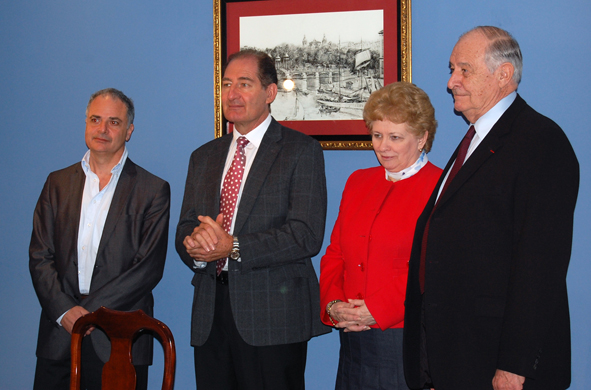The last armed conflict in western Europe: the final steps to peace
(English translation of the article originally published in Le Temps)
The last armed conflict in continental Europe ended exactly two years ago. But the fight for peace remains as long as the ETA is not ready to disarm and dissolve and the Madric government does not review its penitentiary policy. Pierre Hazan is a member of the International Contact Group on the Basque Conflict, co-organizer of the peace conference, international justice specialist, and professor at the Center for Research and Humanitarian Action. He is working with Fondation Hirondelle to create a dedicated news platform on transitional justice.
Two years ago the last armed conflict in continental Europe ended. The armed ETA renounced violence following a peace conference that took place on October 17, 2011 in San Sebastian in the summer residence of General Franco. But the silencing of weapons is not enough. The challenge now is to build a true peace in the face of the Spanish government’s inflexibility and the fact that the ETA has neither disarmed nor announced its dissolution. Hope vies with frustration as transitional justice measures attempt to address the legacy of half a century of violence.
Hope is tangible because, after a thousand deaths and a society marked by years of conflict, this chapter of violence is finally at an end. There is more hope still because of the launch of many transitional justice initiatives aimed at building a true peace. The Abertzale left wing independence movement has made timid pleas for forgiveness from the victims of the ETA and has called for the creation of a truth and reconciliation commission. Members of the ETA have also publicly expressed “regret.” In 2012 the “Glentree” initiative was made public – an initiative that brought together ETA victims, victims of the GAL paramilitary commandos, victims of the far-right and victims of police violence, discretely and over the course of five years, with this group agreeing on a document acknowledging the suffering and calling on society to work on a process of reconciliation.
Equally significant, in June 2012 the Basque government approved a decree that offers assistance to victims of torture and police violence committed between 1960 and 1978, namely after the creation of the ETA under the Franco dictatorship through the adoption of the Spanish Constitution and the return to democracy.
The Basque parliament will now decide on whether to create a commission to investigate allegations of torture and mistreatment by Spanish security forces from 1978 to 2013. This decision is critical, both from a political and a judicial perspective. For Madrid, the only victims are those that suffered at the hands of the ETA. This decision is made all the more difficult for the Spanish authorities by the fact that should it emerge that the confessions of ETA members were extracted under torture, this evidence would not be admissible in court. More than 10,000 Basques say they were tortured by Spanish security forces, and various UN bodies believe that mistreatment and torture were indeed committed by these forces.
At the behest of the Basque government, a working group comprising people from a variety of political affiliations was formed to investigate the acts of violence committed by all parties during the decades of conflict. The group’s conclusions, made public recently, are that the ETA killed 837 people and wounded 2500 others, security forces killed 94 people and wounded close to 750, to which the victims of paramilitary and extreme right groups should be added, thus an additional 73 deaths and 400 injured. Madrid disputes this analysis, refusing to expand the category of victims beyond those of the ETA. Nevertheless, all of these transitional justice initiatives succeed in creating an environment that is more favorable to the resolution of the conflict.
That said, several sticking points remain. The ETA still exists. The armed group has hinted that it is ready to disarm, which would be a prerequisite for its dissolution. In return, the group wants assurances regarding the 650 members of the ETA held prisoner in Spanish and French prisons. Madrid and Paris could abandon the policy of dispersing ETA prisoners, and Madrid could also terminate the Parot policy, which permits the government to detain prisoners long after their release dates. The government has been encouraged to abandon this policy following the recent ruling of the European Human Rights Tribunal demanding the release of an ETA militant held under the Parot policy.
These confidence-building measures are necessary to reflect the current political reality in the Basque country. The dynamic created by the past two years of peace has produced undeniable results. The intimidation and the so-called “revolutionary tax” levied by the ETA to maintain its clandestine network no longer exist. Elections take place in a peaceful environment. With 25 percent of the vote in the 2011 elections, the nationalist separatists have become the second political force in the Basque country, behind the PNV, the Basque Nationalist (but not separatist) party, which garnered 34 percent of the vote. The conflict has thus shifted to the political realm, even though Madrid clings to its vision of a unified Spain and Basque nationalists continue to insist on their right to self-determination.
But the transformation of the situation in the Basque country has been met with an uncompromising attitude pervading the government in Madrid, with the government refraining from participating in the peace conference in October 2011 and refusing to revise its detention policies. This attitude has provoked frustration among a large segment of the Basque population. The Spanish government presumably believes that it has nothing to fear with the ETA’s unilateral renunciation of armed struggle, thus eliminating the security threat the organization has posed for decades, unless the group were to return to armed conflict, a move that would cause the organization to lose all credibility.
However, Madrid’s policy poses its own dangers. There is a need for the ETA’s abandonment of arms to be recognized by the Spanish authorities. This would force those militants who have lived for years in ivory towers, fixed in their ideological certainties, to reformulate an identity that is far more inclusive and allow them to reintegrate into the society that they have been fighting against. The Spanish government could pursue initiatives along these lines, particularly in ending its policy of dispersing prisoners.
With the death of General Franco, the transition to democracy was built on the “pacto de olvido” (“The Pact of Forgetting”). This second transition is committed to definitively ending the decades of conflict in the Basque country. And this transition, unlike the previous one, will not be based on forgetting, but on the recognition of responsibility.
Pierre Hazan, Geneva



